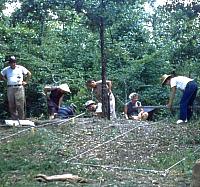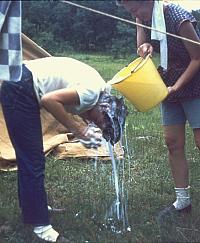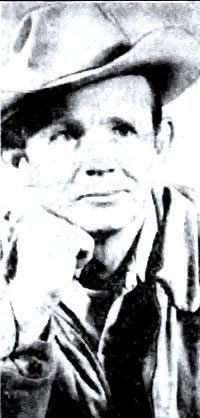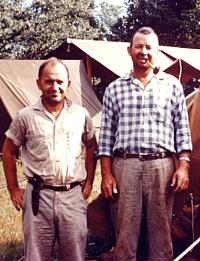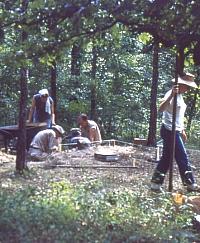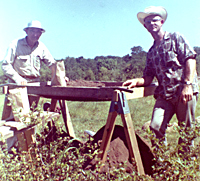The Gilbert Site, 1962: Birth of the TAS Field School |
||
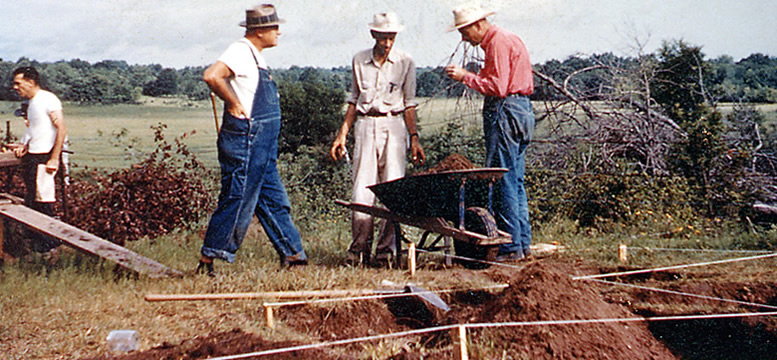 Gilbert excavations in progress, 1962.
|
||
|
By Ed Jelks The 1962 dig at the Gilbert site, co-sponsored by the Texas Archeological Society (TAS) and the Dallas Archaeological Society (DAS), planted a seed that grew into the annual TAS field school, a tradition that has continued unbroken from 1962 until the present. It all began early in 1962 when Harold Atkins of Sulphur Springs mailed me some artifacts he had found at a site on the upper Sabine to see if I could identify them. They consisted largely of eighteenth-century trade goods, including fittings from typical French trade guns. Lathel (Duffy) Duffield, R. K. (King) Harris, and I had developed a strong interest over the preceding three or four years in the archeology of the southern Wichita groups, the archeological expression of which Duffy and I had defined in 1961 as the Norteño Focus. So I became very excited about the prospect that here was another important Norteño site in Texas. I visited the site with King a few days later and was impressed with its potential. I was panting and drooling to excavate at Gilbert, but there were no funds available for that purpose. Then an idea struck me: Why not have the TAS sponsor a dig there, with TAS members providing volunteer labor in exchange for gaining hands-on field experience under the direction of professionals? I broached the idea to UT colleagues Mott Davis, Dee Ann Story, and Duffy, and they endorsed it enthusiastically, each agreeing to take a turn at directing the dig. So I organized the dig as a TAS project, with the Dallas Archaeological Society a co-sponsor. The plan was to have TAS members provide the labor, and those members who so desired would participate in analyzing the data from the site and in writing a site report. It all worked out as planned. More than 70 TAS members turned out to work on the site, many of them also members of the DAS. Twenty-five avocationals and six professionals co-authored the site report, which was published in 1967 as Volume 37 of the Bulletin of the Texas Archeological Society. The project was highly successful by all accounts, so much so that the TAS sponsored a second dig the following summer at the Late Prehistoric Oblate rockshelter at Canyon Reservoir, where Curtis Tunnell was directing salvage excavations. The momentum was building, and the next summer a third TAS dig, by now being called a field school, was organized and directed by Dee Ann Story at the Vinson site, another Norteño component near Tehuacana. By then the tradition of having an annual TAS field school was firmly established. Field School as Instrument of Social BondingThe long-standing tradition of cordial, mutually respectful cooperation between avocational and professional archeologists in Texas was manifest at Gilbert: in the excavation activities, in the learning experiences, and in the socializing that took place. The group would gather after supper every day for a discussion about the field problems encountered during the day, to draft strategies for the next day's excavation, and, to cap the evening, a singing session to the accompaniment of some amateurish guitar plunking by the likes of Mott Davis and me. I resurrected one of the ballads from my childhood, The Sinking of the Titanic, which became the group's favorite song. The Titanic has continued to be sunk and resunk, I believe, just about every evening at every TAS field school since then, with Mott carrying on at the guitar after I moved away from Texas. The tradition of social bonding between individuals that has been a hallmark of the TAS field schools through the years had its beginning at Gilbert. It was there that I met Charlie Bollich, Kathleen Gilmore, Norma Hoffrichter, and Charlie Smith—who became four of my dearest friends—for the first time, and I got better acquainted with others whom I had known more or less casually before: Jay Blaine, Isabelle Lobdell, Roy Padgett, and Dessamae Lorrain, to mention a few. Some of the images that remain burned in my memory include:
I am sure that those who have attended each and every TAS field school since 1962 also have stored up treasured vignettes of field-school personalities and happenings such as these. The social bonds forged each summer in sweat, dust, and storm are instrumental in making the TAS the successful and cohesive organization it continues to be. Today the TAS has some 1500 members, including professional, avocational, and student archeologists, who share a common interest in learning about Texas' past through archeology. To learn more about becoming a member, visit www.txarch.org/. |
||
